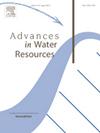Relating flow resistance to equivalent roughness
IF 4
2区 环境科学与生态学
Q1 WATER RESOURCES
引用次数: 0
Abstract
Describing flow resistance using the physical properties of an underlying surface is a recalcitrant problem in overland flow models. If discharge measurements are available, an equivalent roughness (e.g., Manning’s ) can be calibrated to represent the effects of surface properties within the domain with a single numerical value. Alternatively, the flow resistance can be estimated from discharge and velocity measured at a point, typically a runoff plot outlet. However, such experimental estimates are often inconsistent with the equivalent roughness determined from calibration to discharge, even if both derive from the same dataset. For example, if Manning’s equation is used to parameterize flow resistance, the Manning’s obtained by calibrating a model to discharge differs from the value of calculated from measured flow and velocity at the hillslope outlet.
Here, this discrepancy is resolved by deriving a correction factor relating experimentally-determined flow resistance to the equivalent roughness. The derived correction factor is tested for four commonly-used resistance formulations using 129 rainfall simulator experiments. The correction factor is necessary to reproduce measured velocities, and yields minor improvements in discharge prediction.
Plain Language Summary
Accurate runoff prediction is needed for land and water management in dryland regions, where sporadic and limited rainfall necessitate efficient water use and drought mitigation strategies. The skill of runoff models is known to be hindered by out ability to estimate flow resistance, which is the quantity that describes how energy is lost from flowing water to the underlying surface. Typically, models represent flow resistance with an equivalent roughness, e.g., Manning’s , that is adjusted until the model can reproduce available discharge observations at watershed scale. However, the flow resistance measured in plot-scale experiments (1–10 m) often exceeds equivalent roughness coefficients by a factor of 10. This means that the direct use of plot-scale experimental data to parameterize runoff models could cause errors in discharge and runoff velocity predictions.
Here, we resolve these differences by deriving an analytic correction factor that relates flow resistance to the equivalent roughness required for models to reproduce experimental velocity and discharge data. This correction factor is tested using rainfall simulator data from 129 experiments performed in the US Southwest covering a wide range of precipitation intensities, soil textures and vegetation types. Use of the correction factor substantially improves model prediction of flow velocity, which is needed for reproducing the timing of flood events and the estimation of erosion.

将流动阻力与等效粗糙度联系起来
在地表流模型中,利用下垫面的物理性质来描述流动阻力是一个棘手的问题。如果放电测量是可用的,一个等效的粗糙度(例如,曼宁的n)可以被校准,以表示一个单一的数值范围内的表面性质的影响。或者,流动阻力可以通过在某一点测量的流量和速度来估计,通常是径流图出口。然而,这样的实验估计往往与从校准到放电确定的等效粗糙度不一致,即使两者都来自相同的数据集。例如,如果使用Manning方程来参数化流阻,则通过标定模型排出得到的Manning’s n与根据山坡出口的实测流量和速度计算得到的n不同。在这里,通过推导与实验确定的流动阻力与等效粗糙度相关的校正因子来解决这种差异。通过129次降雨模拟试验,对四种常用的阻力公式进行了修正系数的检验。校正系数对于重现测量的速度是必要的,并且在流量预测方面产生了微小的改进。准确的径流预测对于干旱地区的土地和水资源管理是必要的,在这些地区,零星和有限的降雨需要有效的水资源利用和干旱缓解战略。众所周知,径流模型的技巧受到估算流阻的能力的阻碍,流阻是描述从流动的水到下表层的能量损失的量。通常,模型表示具有等效粗糙度的流动阻力,例如Manning 's n,该值经过调整,直到模型能够再现流域尺度上可用的流量观测值。然而,在图尺度实验(1-10米)中测量的流动阻力通常超过等效粗糙度系数10倍。这意味着直接使用图尺度的实验数据来参数化径流模型可能会导致流量和径流速度预测的错误。在这里,我们通过推导一个解析校正因子来解决这些差异,该因子将流动阻力与模型重现实验速度和流量数据所需的等效粗糙度联系起来。该修正系数使用来自美国西南部进行的129次实验的降雨模拟器数据进行了测试,这些实验涵盖了广泛的降水强度、土壤质地和植被类型。校正因子的使用大大提高了模型对流速的预测,而流速是再现洪水事件时间和估算侵蚀所必需的。
本文章由计算机程序翻译,如有差异,请以英文原文为准。
求助全文
约1分钟内获得全文
求助全文
来源期刊

Advances in Water Resources
环境科学-水资源
CiteScore
9.40
自引率
6.40%
发文量
171
审稿时长
36 days
期刊介绍:
Advances in Water Resources provides a forum for the presentation of fundamental scientific advances in the understanding of water resources systems. The scope of Advances in Water Resources includes any combination of theoretical, computational, and experimental approaches used to advance fundamental understanding of surface or subsurface water resources systems or the interaction of these systems with the atmosphere, geosphere, biosphere, and human societies. Manuscripts involving case studies that do not attempt to reach broader conclusions, research on engineering design, applied hydraulics, or water quality and treatment, as well as applications of existing knowledge that do not advance fundamental understanding of hydrological processes, are not appropriate for Advances in Water Resources.
Examples of appropriate topical areas that will be considered include the following:
• Surface and subsurface hydrology
• Hydrometeorology
• Environmental fluid dynamics
• Ecohydrology and ecohydrodynamics
• Multiphase transport phenomena in porous media
• Fluid flow and species transport and reaction processes
 求助内容:
求助内容: 应助结果提醒方式:
应助结果提醒方式:


